We may earn commissions when you buy from links on our site. Why you can trust us.
Olive Union Max Review: A Mixed Bag in OTC Hearing Aids
You’re forgiven if, after seeing the photo of the Olive Union Max ($398, currently discounted to $199) accompanying this review, you rhetorically ask: “That’s a hearing aid?” When I first received my Olive Max review sample, that was pretty much my reaction. Hearing aids are literally meant to be heard and not seen, but the Olive Union Max are as physically obvious as Post Malone’s face tattoos, as a sports fan’s team colors face makeup, as anything Billy Porter wears. Except the conspicuous Olive Union Max design isn’t exactly as stylish as these other unique fashion choices; to me, the Max give off more of a Princess Leia cinnamon buns vibe, which even Carrie Fisher wasn’t wholly thrilled with.
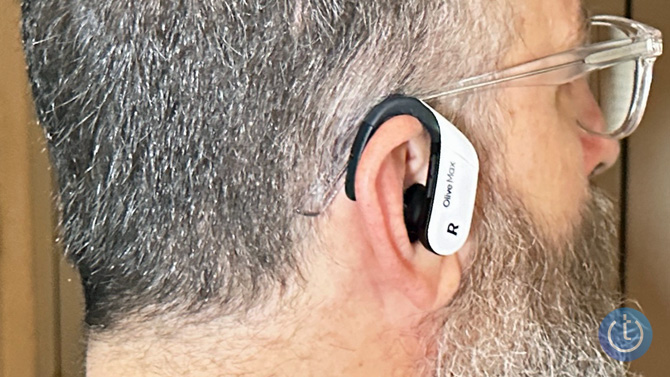
Olive Union can be forgiven for the Max’s ungainly aesthetic if they were aurally effective at boosting your hearing. Yes, the Max provide a LOT of volume – they provide more volume than any OTC hearing aid I’ve tried. But Max’s hearing aid aural effectiveness is not up to sonic snuff. Nearly every sound at even moderate volume levels, especially voices, is tinged with subtle distortion fuzz, making conversations sound akin to a loud speakerphone call.
However, I can see how the Max might be bought solely for its app’s selection of soothing therapy soundscapes. Or, because of their low price, the Max might have a place in an office drawer, to be pulled out and worn during a work day to highlight occasional conferences with co-workers inured to their unlikely looks, or otherwise provide Bluetooth music listening isolation.
But I can’t see how anyone would want to be seen wearing the Max as a hearing aid in public. Essentially, if I don’t want anyone to know you have hearing issues, it should be obvious that the obvious Olive Max are not for you.
| + Pros | – Cons |
|
|
Design
The Olive Max buds measure a clunky 1.90 x 1.63 inches and 1.28 thick and weigh a surprisingly light 0.35 ounces. Each bud is equipped with three mics along with up/down manual volume toggle switches, handy when your phone isn’t handy. Such large buds obviously require a large case – 4.64 x 2.28 x 1.47 inches, not anywhere near pocketable.
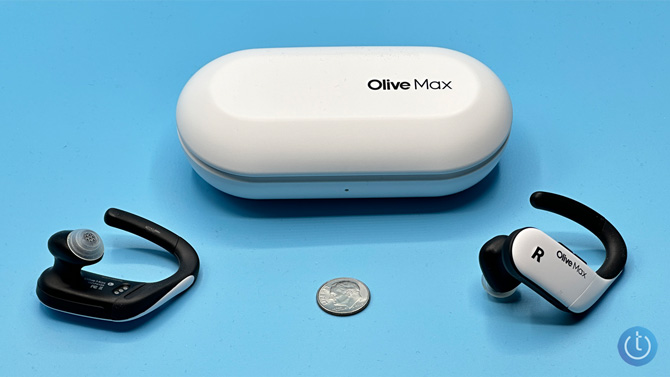
Included are four pairs of XS, S, M, and L canal-sealing urethane ear tips – the medium tips are pre-attached; three pairs of slightly more open SpinFit ear tips; and a single pair of open silicon ear tips. I opted for the latter; while better for music listening, the urethane, and SpinFit tips simply created too much isolation and made the real world sound too artificial.
For charging, you get a USB-A to USB-C cable, and the case is Qi wireless chargeable. An external LED on the case provides charging status, but there are no internal LEDs to let you know if the buds themselves are properly positioned inside the case to be charged.
Setting up the Olive Max
First off, the FDA is getting sloppy certifying hearing aids as “self-fitting,” because the Max ain’t. There is no hearing test in the Max app. Instead, you’re asked nine questions about your age, gender, and about the type and length of hearing loss.
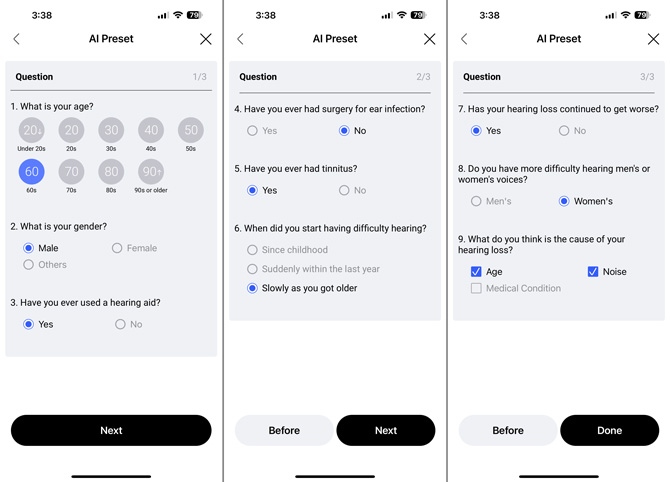
From these questions, the app chooses one of three sonic presets, A, B, or C. Just three. There are an estimated 35 million people in the U.S. with hearing loss, but Olive absurdly believes we all fall into one of three hearing profile categories. Maybe hearing loss profiles aren’t exactly as distinct as fingerprints, but three sizes sure don’t come close to fitting all. How Olive’s app questions qualify as “self-fitting” beggars the imagination, and how the FDA thinks the Max qualifies as meeting any reasonable “self-fitting” qualification beggars it more.
Of course, first, you need to download the My Olive app. Except, there are no instructions in the one-sheet paper guide about downloading an app, of which there are two in the Apple App Store. You want the My Olive app, not Olive Smart Ear.
The My Olive app Control screen fits all the basic adjustments you need on one screen. A unique on/off button turns off the hearing aids, effectively a “mute” button, but leaves the Bluetooth connection active for music streaming and phone calls. Turning the hearing aids back on results in a nearly instantaneous hearing aid re-activation.
You get individual left (blue) and right (red) 1-10 volume level controls, but you can’t combine the volume into a unified single control.
There’s a surprisingly effective three-level noise reduction slide paired with a feedback cancellation on/off. But why optimum noise reduction and automatic feedback cancellation aren’t simply built-in default settings is beyond my ken.
You also can choose between full 360-degree hearing or effective 90-degree focused front microphone settings.
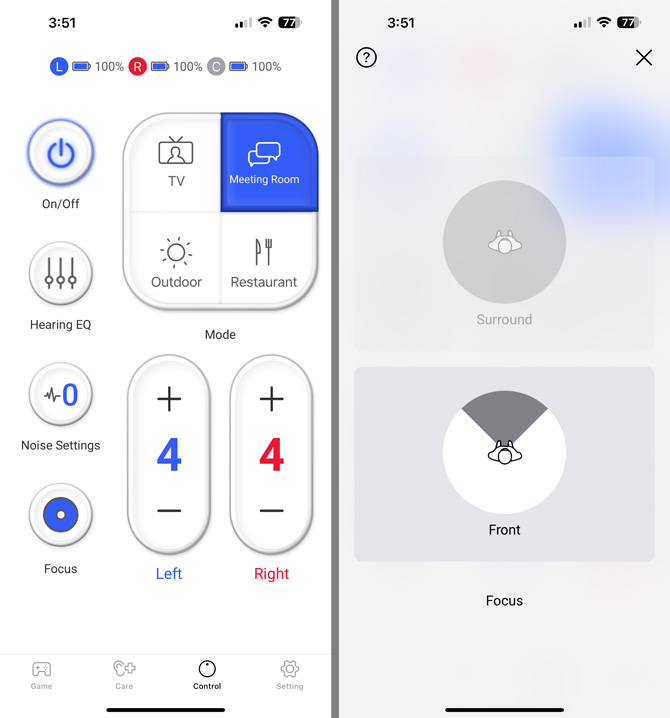
While the “self-fitting” bud programming leaves everything to be desired, the app offers a dizzying plethora of supplementary EQ aural settings, starting with four ambient presets: TV, restaurant, meeting room, outdoor, and restaurant, each of which offers minimal real-world sound adjustments. There is no “normal” or default setting – you must choose one of the presets even if you’re indoors just living your life.
Behind the Hearing EQ icon on the Control screen is a nine-band slide EQ that can be adjusted separately for left and right ears individually or linked for a universal setting, and you can save your settings. Under the EQ itself are EQ presets for “clarify the voices around you,” “clarify the sound,” or “to keep your voice from ringing,” but the differences between each seem too subtle.
Under the separate Settings app icon, you get three more music-specific nine-band EQs: a manual My EQ, Special EQ that lets you name and save your EQ settings, or Basic EQ. The Special and Basic EQs each offer three presets, all of which vastly improve music reproduction quality.
Most impressively, under the separate Care+ home screen icon, you get access to a wonderfully wide variety of soothing ambient “therapy” soundscapes such as “bird in forest,” “waves on the seashore,” “frogs in the lake,” “calm morning in the forest,” and varying colored noises and frequencies. Unfortunately, the app isn’t always navigationally clear about how to access all the options. You also can set a length-of-play timer for the sounds or listen to tones at a variety of volumes and frequencies, the precise utility of which escapes me.
Audio performance
In a double whammy, not only are the Olive Max ungainly, but they don’t clean up sound as well as a hearing aid ought to, either.
While providing plenty of volume and decent clarity, I found it impossible to achieve the kind of natural world sound I got from more hearing aid-first in-ear OTC buds such as Eargo 7 or Zepp Clarity Pixie, or from receiver-in-canal (RIC) models such as the Sennheiser All-Day Clear, regardless of which Max tips I tried. Sounds are marred by slight distortion fuzz, even at low volume levels. In a group conversation, fuzzy voices seem aurally crowded, making it difficult to distinguish different speakers.
Plus, like a cheap personal sound amplification device, every sound is indiscriminately amplified. Running faucets and flushing toilets sound as if you’re next to Niagara Falls. Wood floors creak like a bad horror movie. Light switches sound like rifle shots. Okay, maybe I’m slightly exaggerating, but many noisy settings become a cacophony. Even in Restaurant or Meeting Room mode, and even with the noise reduction set at its optimum level, voices are often polluted by equally amplified ambient sounds such as airflow from vents, fans, air purifiers, or AC, even in a quiet room, or drowned by outdoor traffic and street sounds.
Music listening is actually pretty decent compared to RIC-styled hearing aids thanks to the Max’s included canal-sealing tips. But without noise cancellation, especially if you’re not wearing canal-sealing tips, music is mixed and is often washed out by loud ambient noise. Turning off the hearing aids in the app helps, and you’ll likely need to turn the music volume almost all the way up. In other words, the Max are certainly not comparable or preferable to music-first buds, or even Bluetooth in-ear OTC hearing aids such as the Sony CRE-E10 or the HP Hearing Pro.
Read more: Tested: Can Regular Bluetooth Earbuds Be Used as Hearing Aids?
As with many Bluetooth-enabled OTC RIC-styled buds, the Max aren’t great for phone calls; I got complaints from co-conversationalists that my end of the call wasn’t clear, even while I was in a quiet room.
From a comfort POV, while the Max may be physically clunky, they’re not uncomfortable. There’s a good balance struck, at least in/on my ears, between support from the hard ear hook and the in-ear bud, so they wore easy over several hours. The thin ear hooks accommodated my glass's temples, and the buds stayed in place regardless of how violently I shook my head. Just be careful while putting on and especially pulling off ski caps or scarves.
Battery life is better than its rating but still disappointing considering the Max’s size. Olive says you’ll get 10 hours of single-charge listening, and I regularly got 10.5 to 11 hours, but that's far less than the smaller and far less visible (and far more expensive) RIC-style Sennheiser All-Day Clear. Fortunately, the buds will quick-charge in just 30 minutes, not the multiple hours of recharging required by other OTC hearing aids.
The bottom line

As a Bluetooth-enabled hearing aid, the Olive Union Max don’t do anything much for me. However, I highly recommend the Max for those who enjoy their waking hours accompanied by soothing sounds, especially for those of us who need aural relief from tinnitus. I just wish the app made it easier to access some of the more arcane choices.
If I were to recommend the Max to anyone for their intended hearing aid usage, it would probably be for office workers who could just keep them in their desk for just-in-case usage. Once you let your coworkers know these ungainly Max are actually hearing aids, they’ll get used to the sight of them. Whether you will when you look in the mirror is another issue.
[Image credit: Stewart Wolpin/Techlicious]
Stewart Wolpin has been writing about consumer electronics for more than 35 years, including news, reviews, analysis and history, and has attended and covered nearly 50 Consumer Electronic Shows and around a dozen IFA shows in Berlin. For the Consumer Technology Association (CTA), he is an elector for and writes the official biographies of the annual CT Hall of Fame inductees, and is the keeper of the industry’s official history.
Discussion 
I appreciate you brininging up the Fuzzy sound issue, for me, it is something to think about. However, when it comes to the device look, feel and fit, I think it is very practical. One of the problems I have with BT devices that are ‘hidden’ in the ear, is that they can easily fall off and since I don’t hear the sound on impact with the ground, then the piece is forever lost. Therefore, I give a high 5 for the design, and a prayer that they can fix the Fuzzy sound issue, ad another prayer that they can provide same design for folks with a bit more severe hearing loss.
I got these for my 90 year old mother.. she can only hear in her left ear poorly, the sound quality is subjective for her relating it to me… I have tried several OTC hearing devices on her, this happens to be just another one to to try.. and as mentioned about the aesthetics of it.. with ear buds and the like all over the place.. one would have to be vain to think anybody really cares and that others are even looking.. TRUST
Having had and used these since Aug 2023, I can agree with everything in the review. I will say music through BT is very good and I found myself bringing up lots of music. E.g. you can hear Willie Nelson’s fingers brushing his guitar. Agree not good for phone. Pairing with iPhone on BT was easy but pairing with BT adapter on AV receiver takes several tries after disabling all Apple BT on devices. Now using Apple AirPods Pro 2 when I leave the house that are much better for conversations, esp. in Conversation Awareness mode. Would like to see your review of their new Olive Air set.









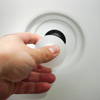






From Rob Moore on February 18, 2024 :: 11:04 am
I can appreciate your review of the Olive Max hearing Aids, but have been using a pair of Phonac aids provided to me by the Veterans Administration at a cost of $8000 to the tax payer. THEY SUCK! And they do NOTHING to improve my hearing situation. In fact,my condition feels worse when I remove them. That being said, I look forward to trying out my Olives when they arrive. At least they didn’t cost me 8 grand.
Reply